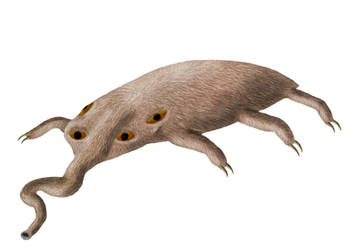Deviation Actions
Description
The variety of fauna and flora hidden inside the ancient islands of the BW is fascinating, not only because there are few unique types of animals, but because its origins. One example has been the Triassic fauna, the first wave of creatures which were able to colonize the bygone world before it was isolated, which despite the time and changes in the last 200 million years, these species remained little changed, and even evolved in new kinds. The strangers Placodonts for example, have found refuge in the islands, and although they are only conformed by a few species, they managed to survive until the days of man. There was discovered two interesting species so far but, apart of them, there is also singular group, which due to their modified anatomy initially was classified as a new branch of the turtles, however, their morphology was quite different from them.
These creatures are popularly called "horseshoes turtles" (Family Diplochelymorphidae), are described as armored reptiles, mainly aquatic dwellers that don’t left the water which inhabit the river systems on the Isa Island. They are characterized mainly by the way its shell is structured, is articulated in the middle of the body, leaving a first shell covering the chest and the second shell covering the abdomen.
Its name of course comes from the fact that were classified initially as a separate branch of the turtles, and it’s quite unusual division of the shell which have a resemblance whit the horseshoes crabs, however, further analysis of the morphology of the skull determined that they were not anapsids like them, but they were diapsids like lizards, and with the discovery of new specimens Placodonts, its place between the others diapsids was determinate. This group was a descendant from the Placochelyidae family, one of the last types of placodonts alive before its imminent extinction in the Triassic outside the archipelago, but was able to find secure inside the freshwater of the islands. It is theorized that upon reaching the island, this group may have suffered from insular dwarfism leaving only smaller species over millions of years.
Until these days, there were classified already 3 genera with 4 species.
Needlejaw (Stenorhynchus cryptohumus)
One of the most common species of this clade, is a good swimmer, carnivorous, characterized by its long, narrow jaw specialized to catch fish and amphibians. It turns out to be one of the most conservative species morphologically speaking, because it still has a body shape similar to their ancestors. Lives near the river banks and channels where water runs slowly, keeping most of the time underwater near the bottom. Its behavior is mainly solitary, and among them only when the amount of food is huge in certain sectors of the rivers or when they need to mate. The Needlejaw is the biggest species between the Horseshoes turtles, with a length of about 50 to 75 cm long.
Boxshell (genus Cubochelonoides sirenomorphus)
This is a peculiar horseshoes turtle that lives mainly in the principal lake of Isa, characterized by its long, rectangular pectoral shell that conforms about 70% of its body. It swims near the bottom of approximately at depths of between 5 to 10 meters, usually in search of small preys like crustaceans and mollusks. They are slow swimmers; the little aerodynamic shape of the body only allows moving at speeds of 5 to 3 kilometers per hour.
Glyptomorphus (genus Glyphostracus)
This robust semispherical species lives near the rocky and marshy areas of the rivers of Isa, mainly in the mangroves, and unlike the other species, it is capable of get outside of the water by climbing on trees or rocks, but it does at night. Its name of course came from its appearance, which resembles one of the extinct xenarthral mammals, the glyptodont.
It is mainly carnivorous, but their diet may also include decomposing plant material, animal carrion, lichens and even fungi. To climb, the turtle Glyptomorphus uses its legs that despite being short are quite muscular, and with huge claws gives to it a great grip. Is fully shielded, whit huge spines around the edges of the shell, the head and tail is hardy thick, the scales have been developed as a scutes and osteoderms, and the little arms are covered by an extension of the pectoral shell. There are actually 2 species of this genus G. oreiopodus an inhabitant of the rivers near the mountains which have a more graying coloration, with a more irregular shell and small spines, it have a length of about 16 cm; and the G. scandedendrus, a mangrove dweller which have a brown coloration and is more big that its mountain relative, with 25 cm of length.
-----------------------------------------------------------------------------------------------
Okay, only for people who do not understand what this is about, this is part of a concept of a community project called Bygone world, a lost world project where different types of animals from the Triassic and some others time periods have survived in a small archipelago in the middle of the Indian ocean
More about it here s1.zetaboards.com/Conceptual_E…

































